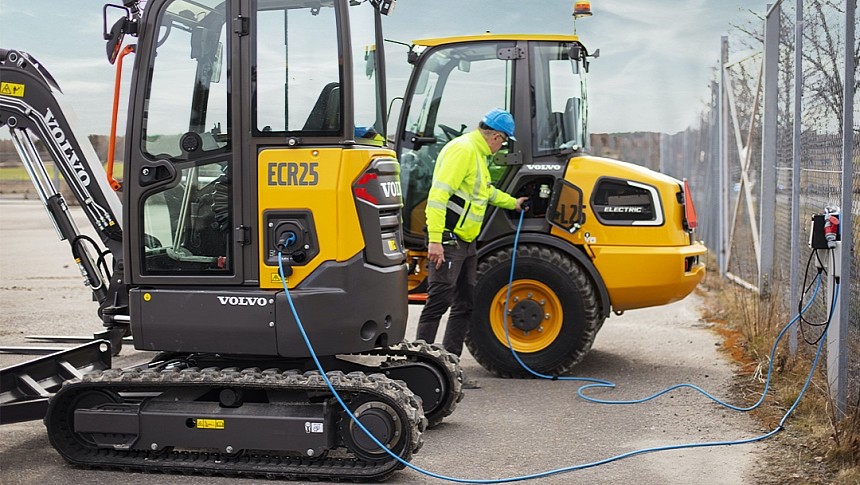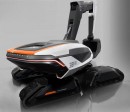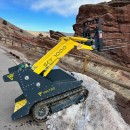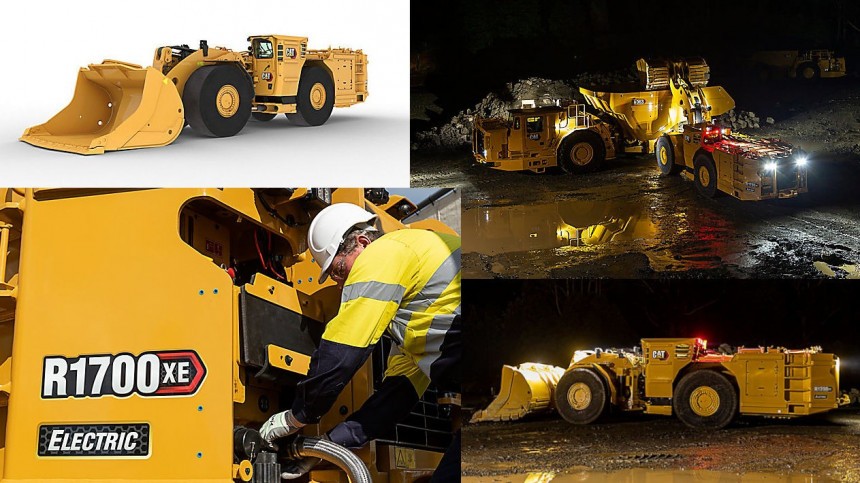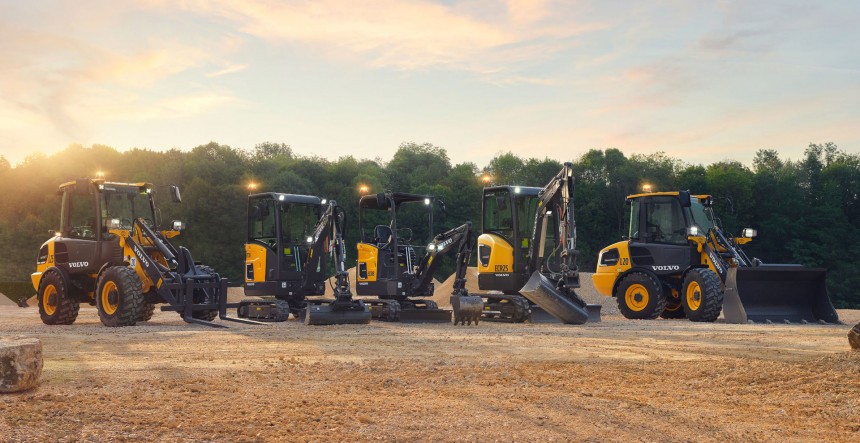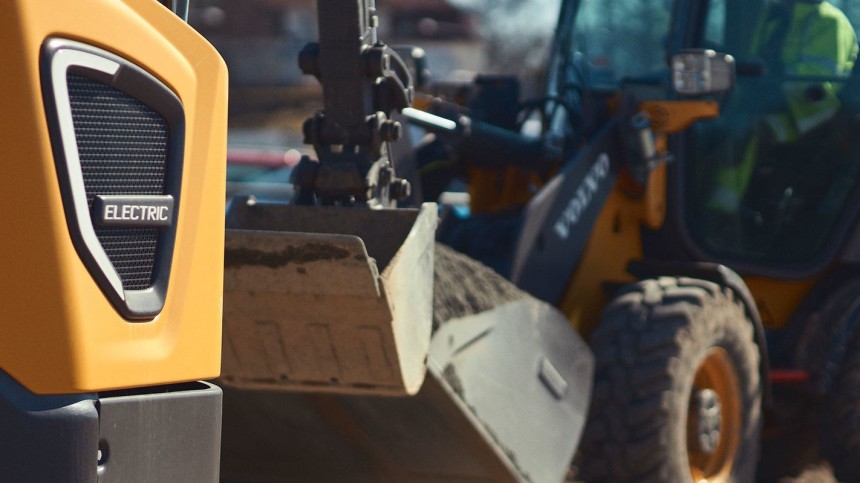According to the UN's Global Status Report for Buildings and Construction, these two sectors combined account for more than a third of global CO2 emissions. A big chunk is because all the heavy machinery needed is powered almost exclusively by big diesel engines. Fortunately, the silent transition to electromobility is faster than you could imagine.
Visitors of CES 2024 enjoyed Honda's 0 Series concepts, several electric VTOLs, and many other electrified, more or less sexy wheeled vehicles. But they were probably puzzled when they saw excavators, loaders, and other working machinery in some booths.
Why, in the name of high-tech, were they on display at CES? They are not exciting at all; they're just tools no one cares about. Actually, they are pretty important. And they signaled a critical, although far from glamorous, trend: the electrification of heavy machinery has started and is evolving at a fast pace.
It has a massive battery, with a total capacity of 213 kWh – less than the 246.8 kWh total capacity of the futile but flashy GMC Hummer EV. Of course, the underground mining loader can't be compared to a luxury SUV because it's not the 11 mph / 17 kph speed that matters the most, but the 33,069 lb / 15 tons payload.
The range is of no importance for such a behemoth as the emphasis is on its dual-ultra-fast-charging capability: less than 20 minutes using CAT's own mobile MEC500 described as an "industry-first standalone Mobile Equipment Charger that can be towed, dragged or fork-lifted."
Now, in 2023, the total number of underground mining loaders is estimated to be around 6,000 units, and their number is projected to rise in the following decades. That's because the overall mining machinery market is forecasted to grow from $24.8 billion / €22.7 billion in 2023 to around $33 billion / €30 billion in 2030 (a third in less than ten years!).
Replacing diesel loaders with electric ones benefits firstly all the miners working underground. Secondly, the mining companies benefit from lower operational costs. Lastly, almost half of mining operations' pollution and emissions are caused by using diesel mining equipment and on-site diesel generators and transporting diesel fuel to the mine site.
In the case of battery production for EVs, mining for the raw materials needed has the most significant impact on BEV production emissions, being higher than ICEV production. As a result, popular wisdom states that electric vehicles are more polluting than internal combustion engine vehicles.
This is true, but remember that differences are not huge – only if we compare an EV to a similar ICEV before customers buy and start using them. After they leave the showroom, the EV will offset its higher emissions in the construction phase after tens of thousands of miles or some years.
So, if we reduce emissions in the mining processes, the EV will be less emissions-guilty than the comparable ICEV from the beginning. That's why electrifying mining equipment is crucial, especially since the range – one of the most significant issues for current electric cars – is of little or no importance at all.
Well, mining trucks accounted for more than half, which is around 100,000 units. And, as you expected, their number is poised to grow in the following decades, especially in Asia-Pacific. Of course, like their siblings transporting goods on the world's roads, mining trucks also run on diesel. But this is going to change pretty fast.
Last year, Volvo Trucks and the Swedish mining group Boliden started a collaboration to use electric Volvo FH Electric trucks. According to Boliden officials, "if all trucks in the mine were to be electric, the CO2 emissions from the mine could be reduced by more than 25 percent."
As the company aims to reduce its CO2 emissions by 40% by 2030, electric trucks are clearly a big step. Not to mention the benefits for workers and operational costs. But for Volvo Trucks, this is just a part of its plans.
In fact, at this point, the North American division of the Swedish producer claims to have "the industry's largest lineup of electric equipment." Small excavators are an exciting example, as they are on the rise due to increasing building projects in restrained areas.
Small electric motors and adequate batteries for a workday are much better than internal combustion engines, thanks also to much lower noise levels and better operational costs. In fact, at CES 2024, there were several such offerings from Caterpillar, Bobcat, or Hyundai.
Well, the mostunattractive conventional was Cat 301.9, while Bobcat Rogue X and Hyundai Concept X are still prototypes. Moreover, they are autonomous little excavators, highlighting the near future for this kind of construction equipment. While AI-driven excavators are not around the corner, battery propulsion is.
Of course, batteries also work with a "low-cost autonomous" tech: at the beginning of this year, the American equipment manufacturer Volteq showcased its new Sky 1000, an electric mini-loader controlled by… remote control. Kind of a drone-on-tracks that can be operated from up to 160 feet / 50 meters away. It reminds me of those robots bomb-squads are using in the movies…
But let's get back to Volvo because the compact wheel loader platform used for L20 and L25 excavators has a wide range of applications thanks to all kinds of attachments, from forks and brackets to different material handling arms.
This way, this electric machinery can also be used in enclosed facilities, like warehouses, where zero-tailpipe emissions and very low noise levels are tremendous advantages. Also, keep in mind that the standard 33 kWh battery is good for 4 to 6 hours of runtime, while the 40 kWh promises up to 8 hours.
Charging on a 32A AC outlet – basically anywhere to be found – requires some 2 hours, while at night, the battery can be charged from a regular 230V outlet in under 5 hours. It's so damn simple that I started to wonder why, in the name of logic, we have to put up with all those noisy machinery in the construction sites all over the cities.
Add to this the buses and trucks requiring larger batteries, but also the hundreds of millions of two- and three-wheelers, which by definition are designed to roam cities with no need for higher ranges. And now, as you can see, some new industries want a slice of the cake.
Well, the good news is that these machinery don't need state-of-the-art batteries. In fact, many research companies forecast that the dominant chemistry for the batteries will be lithium iron phosphate (LFP).
As high-performance or long-range is not critical for most use cases for mining and construction machinery, and the availability of raw materials is not as problematic as is the case with lithium-ion based on nickel and cobalt, these industries' shift to electrification is expected at a faster rate than cars.
Especially since operational costs are much lower, and the taxation system based on emissions and sustainability will only be more favorable. Which in turn could lead to more affordable goods and products in the end. Now, tell me this side-effect is a bad thing!
Why, in the name of high-tech, were they on display at CES? They are not exciting at all; they're just tools no one cares about. Actually, they are pretty important. And they signaled a critical, although far from glamorous, trend: the electrification of heavy machinery has started and is evolving at a fast pace.
No more emissions in the underground
Internet loves cats, but miners love CATs (insert emoticon here). Caterpillar is probably the most famous name in the mining industry, and they exhibited one of the most giant battery-powered wheeled vehicles to date: the R1700 XE LHD loader (LHD is for "Load Haul Dump").It has a massive battery, with a total capacity of 213 kWh – less than the 246.8 kWh total capacity of the futile but flashy GMC Hummer EV. Of course, the underground mining loader can't be compared to a luxury SUV because it's not the 11 mph / 17 kph speed that matters the most, but the 33,069 lb / 15 tons payload.
The range is of no importance for such a behemoth as the emphasis is on its dual-ultra-fast-charging capability: less than 20 minutes using CAT's own mobile MEC500 described as an "industry-first standalone Mobile Equipment Charger that can be towed, dragged or fork-lifted."
Replacing diesel loaders with electric ones benefits firstly all the miners working underground. Secondly, the mining companies benefit from lower operational costs. Lastly, almost half of mining operations' pollution and emissions are caused by using diesel mining equipment and on-site diesel generators and transporting diesel fuel to the mine site.
In the case of battery production for EVs, mining for the raw materials needed has the most significant impact on BEV production emissions, being higher than ICEV production. As a result, popular wisdom states that electric vehicles are more polluting than internal combustion engine vehicles.
This is true, but remember that differences are not huge – only if we compare an EV to a similar ICEV before customers buy and start using them. After they leave the showroom, the EV will offset its higher emissions in the construction phase after tens of thousands of miles or some years.
So, if we reduce emissions in the mining processes, the EV will be less emissions-guilty than the comparable ICEV from the beginning. That's why electrifying mining equipment is crucial, especially since the range – one of the most significant issues for current electric cars – is of little or no importance at all.
No more emissions above the ground, also
Any kid playing with toys knows that a loader needs trucks to dump its load. But I doubt that kids, or even many of you, know how many trucks work underground in the mines. In 2023, the world's total number of mining equipment was estimated to be around 200,000 mining trucks, excavators/shovels, loaders, dozers, and other machines.Well, mining trucks accounted for more than half, which is around 100,000 units. And, as you expected, their number is poised to grow in the following decades, especially in Asia-Pacific. Of course, like their siblings transporting goods on the world's roads, mining trucks also run on diesel. But this is going to change pretty fast.
Last year, Volvo Trucks and the Swedish mining group Boliden started a collaboration to use electric Volvo FH Electric trucks. According to Boliden officials, "if all trucks in the mine were to be electric, the CO2 emissions from the mine could be reduced by more than 25 percent."
As the company aims to reduce its CO2 emissions by 40% by 2030, electric trucks are clearly a big step. Not to mention the benefits for workers and operational costs. But for Volvo Trucks, this is just a part of its plans.
Small electric motors and adequate batteries for a workday are much better than internal combustion engines, thanks also to much lower noise levels and better operational costs. In fact, at CES 2024, there were several such offerings from Caterpillar, Bobcat, or Hyundai.
Well, the most
Of course, batteries also work with a "low-cost autonomous" tech: at the beginning of this year, the American equipment manufacturer Volteq showcased its new Sky 1000, an electric mini-loader controlled by… remote control. Kind of a drone-on-tracks that can be operated from up to 160 feet / 50 meters away. It reminds me of those robots bomb-squads are using in the movies…
This way, this electric machinery can also be used in enclosed facilities, like warehouses, where zero-tailpipe emissions and very low noise levels are tremendous advantages. Also, keep in mind that the standard 33 kWh battery is good for 4 to 6 hours of runtime, while the 40 kWh promises up to 8 hours.
Charging on a 32A AC outlet – basically anywhere to be found – requires some 2 hours, while at night, the battery can be charged from a regular 230V outlet in under 5 hours. It's so damn simple that I started to wonder why, in the name of logic, we have to put up with all those noisy machinery in the construction sites all over the cities.
The mining and construction machinery, the new contender for batteries
The need to electrify these fields is urgent, indeed. Petrolheads will most likely be in favor of prioritizing converting machinery instead of cars, but one problem arises: should we prioritize it? The pressure on raw materials for batteries in the car industry is enormous.Add to this the buses and trucks requiring larger batteries, but also the hundreds of millions of two- and three-wheelers, which by definition are designed to roam cities with no need for higher ranges. And now, as you can see, some new industries want a slice of the cake.
Well, the good news is that these machinery don't need state-of-the-art batteries. In fact, many research companies forecast that the dominant chemistry for the batteries will be lithium iron phosphate (LFP).
Especially since operational costs are much lower, and the taxation system based on emissions and sustainability will only be more favorable. Which in turn could lead to more affordable goods and products in the end. Now, tell me this side-effect is a bad thing!
